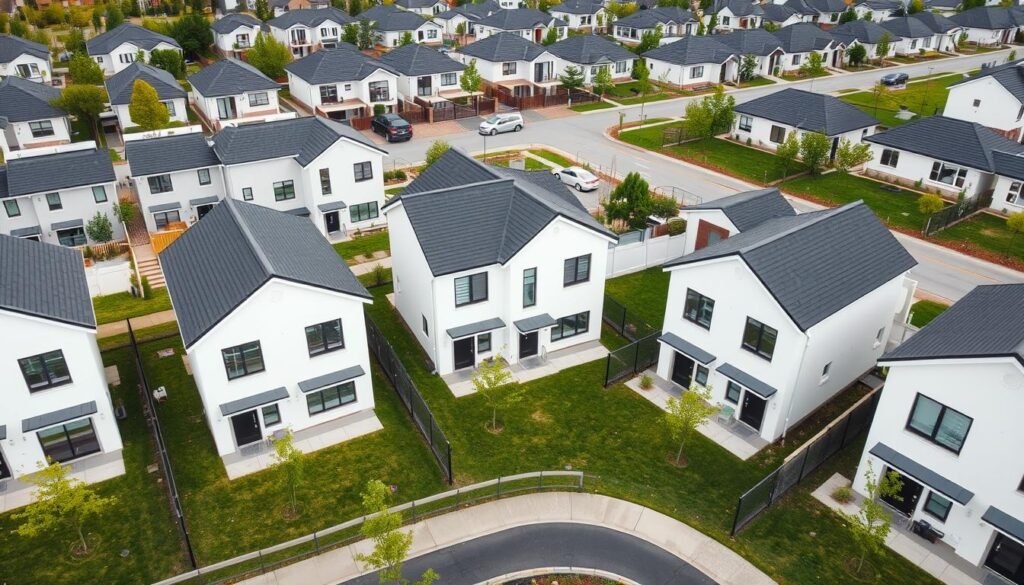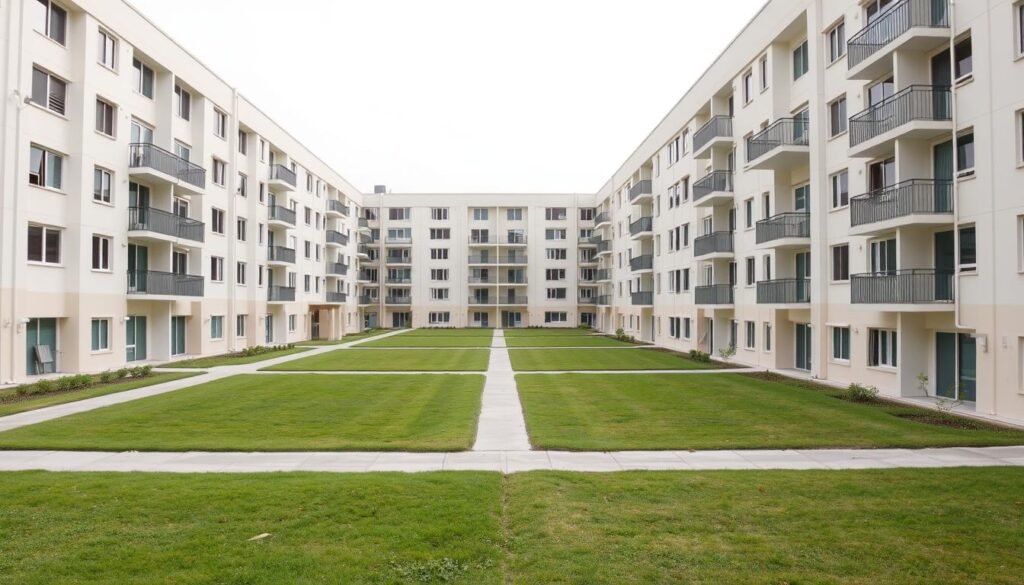Is the traditional property market changing? The UK’s build-to-rent boom is changing the way we invest in homes. Institutional investors are leading this change. They are building new homes just for rent, changing how we live in cities.
The build-to-rent idea is becoming popular. It means homes built just for renting. These homes are owned by big investors like pension funds and REITs. They are making renting better for people in the UK.
In 2023, a record 27,500 build-to-rent homes opened. This is a 75% increase from the year before. Between 2019 and 2023, 41% of new homes were build-to-rent. That’s about 68,000 units.
Big investors are putting a lot of money into build-to-rent. They like the steady income and the chance to grow their property collections. The sector also does well even when the economy is down.
The UK is facing a housing shortage. Young people want different homes. Build-to-rent offers homes with great amenities, flexible leases, and a community feel. It’s a new way to live.
Key Takeaways
- Build-to-rent developments are growing fast in the UK
- Institutional investors are leading because of stable returns
- A record 27,500 build-to-rent homes opened in 2023
- The sector offers modern living solutions aligned with changing tenant preferences
- Build-to-rent properties provide stable income streams for investors
- The model addresses housing shortages and evolving lifestyle demands
Understanding Build-to-Rent: An Emerging Trend
Build-to-rent is changing the UK property scene. It brings a new way to rent homes. This model meets the needs of today’s renters, marking a big change in housing trends.
Definition and Overview
Build-to-rent means homes built just for renting long-term. They are owned by big investors and managed by pros. This gives tenants top-notch places to live with great services.

Key Features of Build-to-Rent
Build-to-rent homes have special features:
- Purpose-built designs with modern amenities
- Professional on-site management
- Community-focused living spaces
- Long-term tenancy options
Differences from Traditional Rental Models
Build-to-rent is different from usual rentals. It creates whole communities. You’ll find shared areas, gyms, and even concierge services.
This attracts a wide range of tenants. 30% are Gen Z, more than in the private sector.
| Feature | Build-to-Rent | Traditional Rental |
|---|---|---|
| Management | Professional, on-site | Often individual landlords |
| Amenities | Extensive, community-focused | Limited |
| Tenant Experience | Enhanced, service-oriented | Variable |
These developments charge higher rents. They are 15-25% more than usual rentals. This shows their high quality and appeal to certain groups.
The Rise of Institutional Investors in the UK
The UK’s rental housing market has changed a lot. Now, big investors play a big role. This is different from when small landlords were more common.
Historical Context of Institutional Investment
Long ago, big investors didn’t own much rental property. In 2008, only 3% of their money was in homes. But by 2023, that number had grown to 9%. This shows more investors want to own rental homes.
Recent Trends and Figures
Now, big investors focus on new types of homes. They like homes built just for rent and for students. Even though they own only 2% of UK homes, their influence is growing.
| Year | Residential Asset % of Institutional Real Estate Capital |
|---|---|
| 2008 | 3% |
| 2023 | 9% |
Impact of Economic Conditions
Money matters have changed how investors see rental homes. Home prices have gone up, making it hard to buy. So, more people rent, and they stay longer. Now, half of renters have been renting for three years or more.

The rental market is stable, with homes almost always full. This makes it appealing to big investors. They think the rental market will grow, making it even more attractive.
Benefits of Build-to-Rent for Investors
The build-to-rent sector is becoming more popular with big investors. It offers advantages over traditional property investments. This is why more investors are interested in it.
Stable Income Streams
Build-to-rent properties give steady cash flows. They have long-term rental contracts and high occupancy rates. This means investors can count on regular returns.
In 2023, the median rent for a three-bedroom house was £1,732. This shows the income these properties can generate.
Lower Vacancy Rates
Build-to-rent properties have low vacancy rates. They often have higher occupancy levels than traditional rentals. This is because they are built for specific needs and preferences.
Diversification of Property Portfolios
Investors are putting more money into rental housing. Build-to-rent is a way to diversify their portfolios. By the end of 2023, big investors owned over 430,000 single-family rental homes.
| Investment Aspect | Traditional Rentals | Build-to-Rent |
|---|---|---|
| Income Stability | Variable | High |
| Vacancy Rates | Higher | Lower |
| Portfolio Diversification | Limited | Extensive |
| Management Efficiency | Individual | Centralised |
In 2022, 120,000 build-to-rent houses started construction. This is 12% of all single-family starts. It shows the sector’s growth and investor interest.
The Role of Government Policy in Build-to-Rent
Government policy is key in the UK’s build-to-rent development. It has helped the private rental sector grow. This is due to laws and plans to tackle housing shortages and make homes more affordable.
Supportive Legislation
The UK government has brought in tax breaks and planning changes. These moves have led to a 35% rise in build-to-rent projects. By 2024, over £10 billion is expected to be invested in this sector.
Planning Permission Considerations
Planning rules have changed to help big rental projects. This has led to a 20% jump in build-to-rent units being built. By 2023, London’s rental homes will hit 100,000, thanks to these policies and better infrastructure.
Environmental and Sustainability Initiatives
Government policies now focus on making build-to-rent projects green. This fits with the goal of creating homes that use less energy and are better for the planet. So, investors are adding eco-friendly features to their buildings, making rental homes more attractive.
| Policy Impact | Percentage |
|---|---|
| Increase in BTR projects in 2020 | 35% |
| BTR units in new housing starts (projected) | 25% |
| BTR properties acquired by institutional investors | 60% |
These government efforts have boosted the private rental sector. Institutional investors have put £3 billion into build-to-rent in the first half of 2023. The sector is set to grow as policies adapt to the housing market’s needs.
Challenges Facing the Build-to-Rent Sector
The UK’s build-to-rent sector is growing fast but faces many challenges. This section looks at the main hurdles developers and investors must overcome.
Regulatory Hurdles
Build-to-rent projects meet complex rules. Getting planning permission can take a long time and cost a lot. Local authorities sometimes find it hard to fit these projects into existing rules.
The sector also deals with special tax issues. These can affect how much money it makes.
Market Saturation Risks
The private rental sector is growing fast. This means there’s a chance of too many homes in some places. Build-to-rent now makes up 10% of single-family homes started.
In just two years, its share has doubled. This could lead to too many homes in popular spots.
Construction and Development Challenges
Building for rent comes with its own set of problems. Developers must design homes that are good for long-term renting. They also need to include shared spaces.
This makes the homes more expensive to build. Also, making homes big enough for families is hard. Homes can be 1,400 to 2,200 square feet.
| Challenge | Impact | Potential Solution |
|---|---|---|
| Regulatory Complexity | Delays in project approval | Early engagement with local authorities |
| Market Saturation | Reduced rental yields | Diversification of locations |
| Construction Costs | Higher initial investment | Innovative design and materials |
Despite these problems, the sector is attracting a lot of money. Companies like AvalonBay are investing big. They see a lot of promise in this trend.
The Tenant Perspective: Advantages of Build-to-Rent
The rise of purpose-built rental housing has brought big benefits to tenants in the UK. As the private rental sector grows, new projects are changing the rental scene. They offer many advantages to those living there.
Flexibility and Lifestyle Options
Build-to-rent developments meet the needs of today’s lifestyles. They offer flexible living options and welcome pets. This is great for a wide range of people.
The average house price has gone up a lot. Now, renting is seen as a better choice for many.
Quality of Living Standards
Purpose-built rental housing has better living standards than old rentals. They have modern features, good management, and clean shared areas. They also focus on being energy efficient.
Community Engagement Initiatives
Build-to-rent projects help build community spirit. They hold social events and have shared spaces. This helps people feel part of a community, which is important in cities.
| Feature | Traditional Rental | Build-to-Rent |
|---|---|---|
| Lease Terms | Often short-term | Longer, more flexible |
| Pet Policy | Frequently restricted | Usually pet-friendly |
| Amenities | Basic | Modern, extensive |
| Community Events | Rare | Regular |
Build-to-rent properties are raising the bar for tenant happiness. They focus on quality, community, and flexibility. These developments are drawing in renters and helping the sector grow, even in tough housing markets.
Financing Options for Build-to-Rent Developments
The build-to-rent sector is booming, thanks to more money from big investors. This change is making the UK’s property scene different. Now, there are many ways to fund big rental projects.
Traditional Financing vs. Alternative Methods
Bank loans are common, but new ways to fund are becoming popular. Options like mezzanine debt and preferred equity give developers more choices. Big investors are also interested in this area for stable returns.
The Role of Real Estate Investment Trusts (REITs)
REITs are key in bringing big money into the rental market. They help both big and small investors get into build-to-rent. REITs make it easy to invest in rental properties without owning them directly.
Crowdfunding and Syndication Opportunities
Crowdfunding and syndication are new ways to fund build-to-rent projects. They let small investors join in on big projects. This makes it easier for more people to invest in rental properties.
| Financing Method | Key Advantage | Typical Investor |
|---|---|---|
| Traditional Bank Loans | Established process | Large developers |
| REITs | Liquidity and diversification | Institutional and individual investors |
| Crowdfunding | Accessibility for smaller investors | Retail investors |
The build-to-rent sector is growing, and so are its funding options. This variety is important for keeping the growth going. It helps meet the UK’s need for more rental homes.
Case Studies of Successful Build-to-Rent Developments
The build-to-rent sector in the UK is growing fast. Many successful projects show its promise. They give us a glimpse into the future of renting homes.
Key Projects Across the UK
Wembley Park in London is a big success. It has over 5,000 homes with cool features like a gym and cinema. In Manchester, Affinity Living has 677 apartments for young professionals.
Lessons Learned from Past Experiences
These projects teach us a lot. Location is key, with transport links and city centres being best. Building a community is also important, with shared spaces and events.
Innovations in Design and Management
Build-to-rent is leading in design and management. Smart home tech lets people control their homes with phones. Sustainable buildings are common, like Moda Living’s Angel Gardens in Manchester.
| Project | Location | Units | Key Features |
|---|---|---|---|
| Wembley Park | London | 5,000+ | Gym, cinema, shared workspaces |
| Affinity Living | Manchester | 677 | Two towers, city-centre location |
| Angel Gardens | Manchester | 466 | Rooftop gardens, energy-efficient systems |
These examples show why build-to-rent is popular. It’s a stable choice for renters and investors. As it grows, it will help solve the UK’s housing problems.
The Future of Build-to-Rent Investment Strategies
The build-to-rent (BTR) sector in the UK is set to grow a lot. This is because of trends in multifamily housing and more investment in rental homes. As the private rental sector grows, investors and developers are changing their plans. They are doing this to meet what tenants want and what the market needs.
Predictions for Market Growth
The North East BTR sector is growing fast, with big projects in Newcastle. The Pottery Lane development is a great example. It will have 519 units in two phases.
Phase one will have 292 private units by late 2026. Then, 227 homes will be added in 2027.
| Development Phase | Number of Units | Completion Year |
|---|---|---|
| Phase One | 292 | 2026 |
| Phase Two | 227 | 2027 |
Emerging Trends in Tenant Preferences
Tenant preferences are changing, with a focus on flexibility and quality of life. The single-family rental (SFR) sector is small but growing. It now makes up 0.3% of privately rented houses in the UK.
SFR developments attract a variety of tenants. 42% of them move from outside local areas. And 66% are between 26-45 years old.
Technological Advancements in Property Management
Technology is changing how we manage BTR properties. New energy rules mean all rented homes must have an EPC rating of C or above by 2028. New build SFR homes are already 100% compliant.
This focus on sustainability fits with the growing importance of ESG in rental housing investment.
Conclusion: Is Build-to-Rent Here to Stay?
The build-to-rent boom is changing the UK’s private rental sector. The UK needs 2.5 million more homes. Institutional investors see this as a chance for steady profits.
Recap of Key Findings
The build-to-rent sector is growing fast. It’s driven by strong demand and good market conditions. The new Labour government wants to build 1.85 million homes in their first term.
Residential property prices are likely to stay high. This makes build-to-rent attractive for investors and tenants.
Long-term Prospects for Institutional Investors
Institutional investors look good for the long run in build-to-rent. Big names like Legal & General are ready to take advantage. They are involved in almost 25% of UK mortgages.
Stable inflation and lower interest rates in 2024 will help. This will make the property market more optimistic.
Final Thoughts on the Sector’s Evolution
The build-to-rent sector is changing the UK rental market. It focuses on quality and amenities. This meets what tenants want.
Institutional investors are leading the way. They are making the sector better. Build-to-rent is set to stay in the UK’s housing scene. It offers a solution to the housing shortage.




